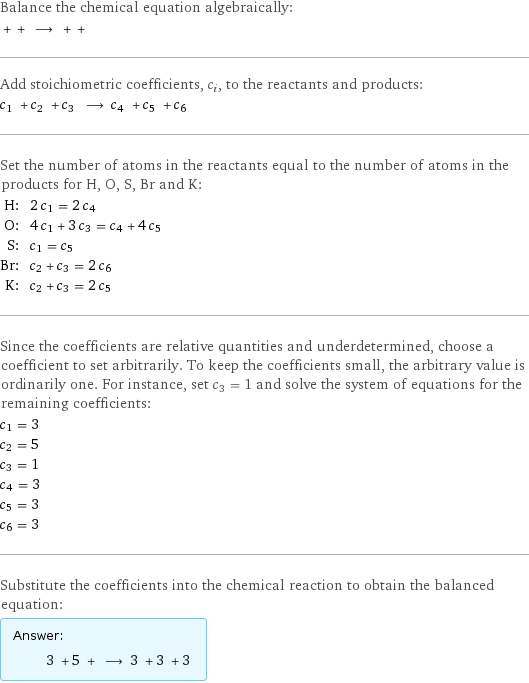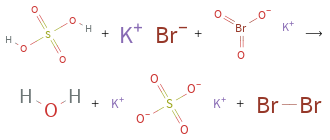Input interpretation

sulfuric acid + potassium bromide + potassium bromate ⟶ water + potassium sulfate + bromine
Balanced equation

Balance the chemical equation algebraically: + + ⟶ + + Add stoichiometric coefficients, c_i, to the reactants and products: c_1 + c_2 + c_3 ⟶ c_4 + c_5 + c_6 Set the number of atoms in the reactants equal to the number of atoms in the products for H, O, S, Br and K: H: | 2 c_1 = 2 c_4 O: | 4 c_1 + 3 c_3 = c_4 + 4 c_5 S: | c_1 = c_5 Br: | c_2 + c_3 = 2 c_6 K: | c_2 + c_3 = 2 c_5 Since the coefficients are relative quantities and underdetermined, choose a coefficient to set arbitrarily. To keep the coefficients small, the arbitrary value is ordinarily one. For instance, set c_3 = 1 and solve the system of equations for the remaining coefficients: c_1 = 3 c_2 = 5 c_3 = 1 c_4 = 3 c_5 = 3 c_6 = 3 Substitute the coefficients into the chemical reaction to obtain the balanced equation: Answer: | | 3 + 5 + ⟶ 3 + 3 + 3
Structures

+ + ⟶ + +
Names

sulfuric acid + potassium bromide + potassium bromate ⟶ water + potassium sulfate + bromine
Chemical names and formulas

| sulfuric acid | potassium bromide | potassium bromate | water | potassium sulfate | bromine Hill formula | H_2O_4S | BrK | BrKO_3 | H_2O | K_2O_4S | Br_2 name | sulfuric acid | potassium bromide | potassium bromate | water | potassium sulfate | bromine IUPAC name | sulfuric acid | potassium bromide | potassium bromate | water | dipotassium sulfate | molecular bromine